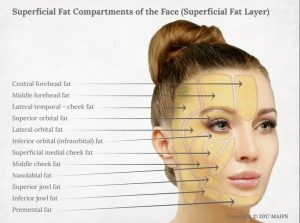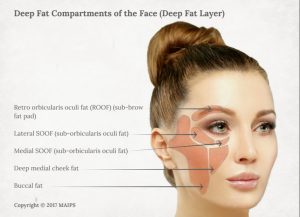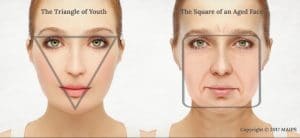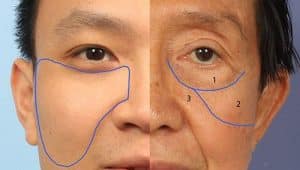The Anatomical Changes of Facial Aging
You can usually estimate someone’s age with a momentary glance at their face. How? It’s because our brains associate certain facial proportions, shadows, tone, and skin texture with general age ranges.


Babies and children have smooth facial contours and evenly colored skin without shadows. Older people’s faces develop depressions that cause shadows, sagging, and rough or irregularly colored skin. Firm highly elastic skin eventually becomes flaccid and thin, with enlarged blood vessels, brown spots, and bumpy growths.
Volume Loss in the Aging Face
Much of what produces the three-dimensional changes that make our youthful triangular-shaped faces become grim rectangles when we get older is the loss of fat and bone that provide the framework for the skin. Our cheeks become our jowls and the skin that started on our jawlines ends up under our chins. To understand how much volume we’re losing from our face as we age, consider that we lose about 1 teaspoon of fat & bone each year after the age of 25 so that by the age of 50, we’ve lost about 1/2 cup.
 Fat Loss
Fat Loss
One of the many cruelties of aging is that we tend to lose fat from the upper & mid-face before losing it in the lower face. Research has shown that fat in the face is partitioned into two layers of separate compartments with the superficial fat pads on top of the muscles and the deep compartments below them.
 The superficial fat provides both structure and a plane to allow the skin to glide over the structures below. Deep fat pockets provide the underlying structure for the skin over the bone. Different fat pads start shrinking at different ages.
The superficial fat provides both structure and a plane to allow the skin to glide over the structures below. Deep fat pockets provide the underlying structure for the skin over the bone. Different fat pads start shrinking at different ages.
 The fat under our eyes starts to decrease the earliest, beginning in our twenties, and is followed in our thirties by the beginning of the loss of fat in the temples and parts of the cheeks. The superficial fat tends to persist unless there’s major weight loss. With the loss of deep fat, the superficial fat loses some of its underlying support and starts to sag.
The fat under our eyes starts to decrease the earliest, beginning in our twenties, and is followed in our thirties by the beginning of the loss of fat in the temples and parts of the cheeks. The superficial fat tends to persist unless there’s major weight loss. With the loss of deep fat, the superficial fat loses some of its underlying support and starts to sag.
Bone Loss
Besides fat, we also start losing facial bone as we age, which is the frame upon which our facial fat, muscle, and skin are suspended. Like fat, some bony areas shrink faster than others, especially around the eye sockets, under the nose, around the mouth & chin, and the back of the jawline. The bony resorption in these areas combined with fat loss is why we develop the appearance of bags under our eyes and jowls.
Loose Facial Ligaments
Facial ligaments also play an important role in facial aging. Facial ligaments are fibrous bands of tissue between the fat pads that connect the skin to the bone or muscles and hold the skin in place. As the fat pads shrink, the ligaments pull on the sagging skin and cause depressions or grooves between the fat compartments. These grooves break up the previously smooth contours of the youthful face into the hills and valleys associated with an aged face.
With aging, the skin may thin up to 80%, its texture becomes rougher and it loses elasticity, especially in sun-exposed areas. Oil glands produce less oil so the skin becomes drier and skin color looks more mottled as the pigment production becomes erratic. Blood vessels may become dilated and visible, especially around the nose. Skin cells turn over slower leading to dull, rough skin at the surface and growths like crusty seborrheic keratoses and cherry angiomas occur more commonly in older adults.So how do we reverse these changes to look more like the age we feel on the inside?




 Fat Loss
Fat Loss